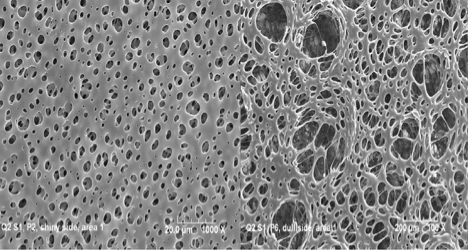
Blood separation membranes play a crucial role in diagnostic assays by facilitating the separation and isolation of plasma from whole blood samples.
We offer Primecare™ Poly-ether Sulfone (PES) Asymmetric Red Blood Cell Separation Membranes for rapidly separating red blood cells from plasma and collecting plasma. In an asymmetric membrane, blood enters the surface of the membrane containing large pores/openings (See image below). The Red Blood Cells (RBCs) become trapped as the membrane transitions to smaller and smaller pores with the resulting plasma exiting the opposite side of the membrane.
Primecare Membranes can be manufactured to a variety of different specifications including thickness and final pore size to suit the performance requirements of in-vitro-diagnostic (IVD) devices (including speed of RBC separation and quality of plasma. These membranes can be used to separate whole blood for a variety of different IVD platforms including quantitative and qualitative lateral flow point-of-care test kits as well as instrument-based microfluidic devices.
Primecare Asymmetric Membranes

Primecare Membrane Properties
- High separation efficiency per cm2, 60-70% of whole blood volume depending on hematocrit
- Customized coating solutions to reduce or eliminate RBC hemolysis
- Customized pore sizes and thickness to prevent RBC leakage or to simply slow RBC migration
- Separation time of ~ 60 seconds per cm2, depending on hematocrit and membrane characteristics (thickness and mean flow porosity)
- Membrane surfaces are inert and are resistant to protein binding
Contact our technical team who can assist you in identifying the appropriate membrane for your requirements or to customize membrane properties to better suit your individual assay demands.